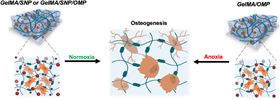 Schematic of the effect of OMP, silicate nanoparticles (SNP), and SNP/OMP on the differentiation of human stem cells towards osteogenesis under normal oxygen and depleted oxygen conditions (normoxia and anoxia, respectively).
Schematic of the effect of OMP, silicate nanoparticles (SNP), and SNP/OMP on the differentiation of human stem cells towards osteogenesis under normal oxygen and depleted oxygen conditions (normoxia and anoxia, respectively).Engineered biomaterial scaffolds embedded with cells for treating bone-related traumas like severe fractures can suffer from a lack of oxygen, especially when a large implant is required. An oxygen supply is vital not only to catalyze cell metabolism and tissue regeneration, but also to support the development of blood vessels, collagen, and other extracellular matrix components. Introducing the ability to release oxygen from implants offers a potential approach to improving bone tissue engineering and regeneration.
Now researchers have developed hydrogels incorporating oxygen-generating microparticles (OMPs) that drive the differentiation of human stem cells into osteoblasts, boosting the potential for regenerative medicine [Hassan et al., Biomaterials 300 (2023) 122179, https://doi.org/10.1016/j.biomaterials.2023.122179].
“As a result of limitations in biofabrication, it is still not possible to fabricate clinical-sized engineered living implants that can be sustained for more than a couple of weeks or succeed as potential biomaterials for long-term use,” explains first author of the study, Shabir Hassan of Khalifa University in the United Arab Emirates.
Together with colleagues at Harvard Medical School and Brigham and Women’s Hospital, Broad Institute of MIT and Harvard, University of Illinois Chicago, University Twente in the Netherlands, Incheon National University in South Korea, Sichuan University and Nanjing Medical University in China led by Jeroen Leijten and Su Ryon Shin, the researchers have developed a platform that not only provides a vascularization-inducing oxygenating microenvironment but also tailorable mechanical properties. The OMPs based on calcium peroxide release oxygen over a prolonged period, while silicate nanoparticles provide mechanical robustness.
Stem cells introduced into the platform can be induced to differentiate into specific tissues such as bone or cartilage, depending on the environmental conditions. In vitro, the researchers observed that OMPs improve cell survival and proliferation, while self-oxygenation supports enhanced vascularization.
“By introducing oxygenating micro-materials, our platform can be used to make thicker tissues and, by changing the environmental conditions, [we can] choose whether we make bone or cartilage,” says Hassan.
Oxygenating implants during the initial period of vascular development is particularly crucial, believe the researchers. The incorporation of oxygen-generating biomaterials into implant scaffolds is a promising approach to improving outcomes in the formation of functional living tissue when treating bone traumas.
“Our preliminary results suggest our approach is practical,” points out Hassan. “However, bone formation and osteogenesis are very complex biological processes [and] more studies are needed to understand the mechanism of action of these oxygenating micro-materials.